#unif model
Text


yuki beniya for unif
15 notes
·
View notes
Text

#plasmoid unification model#atomic engine#randall carlson#molten sea ark atomic reconstruction technology#m.s.a.a.r.t.#p.u.m.
1 note
·
View note
Text
Kovich: Evidence of the Progenitors was first uncovered 800 years ago, by a Starfleet captain named Jean-Luc Picard--
Burnham: Wait, the guy who fucked my dad?
Kovich: ???
Burnham: Yeah, yeah, yeah, I was reading about Sarek's life after I left for the future, and apparently, he had to mindmeld with this guy after he contracted Bendii Syndrome, and he spent the last few years of his life, like, katrically bonded to him.
Kovich: I see. Well, he was considered to be one of the foremost diplomats of the 24th century. Now, if we could return to the matter at hand--
Burnham: I think he also recorded my brother's Unification speech.
Kovich: ...
Burnham: Like that big speech he gave talking about how he was going to reunite the Vulcans and the Romulans.
Kovich: An interesting coincidence. Anyway, these Progenitors are considered to have engineered all humanoid life throughout the Milky Way--
Burnham: And wait, wasn't he the guy who modelled the mind-uploading process Dr. Culber used on Grey last year?
Kovich: Captain Burnham, I'm going to need you to focus up.
Burnham: Okay, sorry, you have my complete attention.
Kovich: Anyways, your next mission will take you to a Promellian graveyard planet. Now, the Promellian are an extinct civilization--
Burnham: Were they discovered by Jean-Luc Picard?
Kovich: ...No.
Burnham: Okay, good. I was starting to worry--
Kovich: But he *did* discover the most complete known specimen of one of their battle cruisers.
Burnham: Damn it!
#star trek discovery#spoilers#red directive#under the twin moons#michael burnham#kovich#david cronenberg#jean luc picard#star trek the next generation#star trek picard#spock#sarek
154 notes
·
View notes
Text
Fascism, it's an oft misunderstood ideological framework, and is often misrepresented by those wishing to mock, or disavow it.
Fascism is a totalitarian political ideology that can be better described as state corporatism, Giovanni Gentile, the father of Fascism, considered Fascism the fulfilment of the Risorgimento ideals, which serve as the basis of Fascism.
Fascism, by definition, and in its foundations was about unifying Italy under one flag, a struggle for unification and liberation from foreign domination, be it financial, physical or political domination.
Quite a lot of people like to think of Hitler's Germany as a Fascist state, it wasn't, it was similar, but the two differed, the similarities can be attributed to the fact the leaders of both nations were both former Socialists, who believed that Socialism was too slow and adhered too much to bourgeois values.
A key concept of the essay The Doctrine of Fascism was that fascism was a rejection of previous models;
"Granted that the nineteenth century was the century of socialism, liberalism, democracy, this does not mean that the twentieth century must also be the century of socialism, liberalism, democracy. Political doctrines pass; nations remain. We are free to believe that this is the century of authority, a century tending to the "right", a Fascist century.
If the nineteenth century was the century of the individual (liberalism implies individualism) we are free to believe that this is the "collective" century, and therefore the century of the State."
Benito Mussolini and Giovanni Gentile co-wrote this essay, and later had it published in the Italian Encyclopedia.
In 1940, Mussolini ordered all remaining copies of the document, which had different editions and translations, to be destroyed, because he changed his mind about certain points, that being his vision of Italy not expanding beyond its borders, and decrying war, he changed his view because he saw the Allies on the decline, and decided he'd rather join the winning side rather than be subsumed into Germany for remaining neutral.
Fascism was, in Italy, an ideology that decried war, expounded the state above the individual, and pushed corporatism, there were no individual rights, only collective rights.
Now, why do I say Hitler's Germany wasn't Fascist? Because beyond the superficial aesthetics, it wasn't, it was still very much Socialist, a Nationalist form of Socialism mind you, rather than the other forms which promoted a Globalist form of Socialism, or, if Hitler's Germany followed National Socialism, the other Socialist states adhered to International Socialism.
Today, academics try with all their might to muddy the waters in an attempt to separate Hitler's Germany from Socialism, and to align it with Fascism, when, if you read what the founders of each political ideology believed and wrote, you'd understand they are only superficially similar, with Hitler's Germany being closer to Imperial Japan and Stalin's Russia in its ideological framework than Italy.
It's why Mein Kampf reads like the Ragged-Trousered Philanthropists, a Socialist propaganda book, though I will add both Mussolini and Hitler loathed Capitalism, which Giovanni Gentile did not, but did see Fascism as the logical evolution of Socialism, so while both Fascism and National Socialism are forms of Socialism, they aren't identical.
Now, don't take this as me defending either, this is just my attempt to air a grievance I've had with people labeling everything they don't like as Fascist.
Such as Starship Troopers and Heinlein, a Libertarian book about a Libertarian utopia fighting space bugs that act as an allegory for Communism, written by a staunch Libertarian.
I think the thing that set me off, was someone on that long thread posted videos by some fat guy on YouTube, in which he invited all of his family on to discuss the novel, and they all take the wrong message from it, but the thing that really did it was his criticism of Heinlein being a military man, and then saying he can talk on it because, despite none of his family being in the Military, him and his brother were in the fucking scouts.
And then he made a long rambling video defending Verhoeven who uses the aesthetic argument of what makes something Fascist, and then uses another person who does the same thing, and I just lost it.
He even brought up the fact Neil Patrick Harris' character comes on to the screen at the end in a "Fascist" uniform, and goes "this is where Verhoeven said he lost the audience, because this scene beats them over the skull with the fact the Federation is Fascist!"

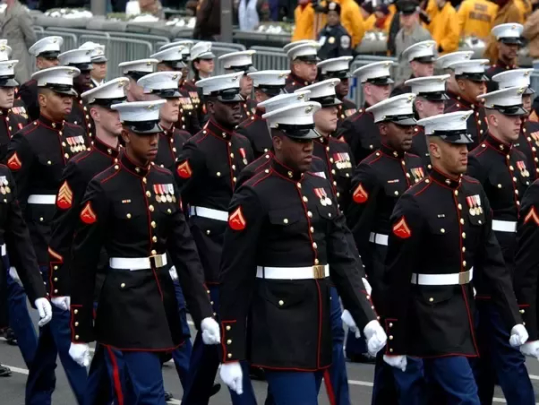
And I'm just fucking frothing at the mouth, these people really don't understand Fascism beyond the basic aesthetics of it, clean, in shape soldiers, chiseled jaws, full hair, clean cuts, he even lists these as if they're evidence, as if these aren't the features every society since the beginning of time has looked for in its soldier or warrior caste, no I guess being physically fit and ready to serve makes you a fucking Fascist to that butter ball of a man.
And God forbid your army has a Fashion sense, some troglodyte will come after it saying it's Fascist, and God forbid you use black or grey in your clothing, ooh, it's gonna activate some almonds.
Fucking morons, can't read past the surface level of anything they encounter.
200 notes
·
View notes
Note
Interested to hear your interpretation on Suburban Legends
first off the song and beat sounds so similar to mastermind and gold rush. particularly mastermind. listen to the opening seconds back to back! she sings through a lot of it similarly in my opinion
and it has some of the similar mechanics of mastermind in that it leads you to believe the song is going one way but then pulls a switcheroo on you at the end and the swell in the music aids that at the end which makes it a really sweet and emotional listening experience. i’ll get to that in a second.

i think at the beginning of taylor knowing or being aware of karlie (so like, your kitchen or mine times), this was very much the situation. karlie is in her peripheral vision (on her radar) but just as taylor described in gold rush, karlie seemed like something utterly unattainable. in lover as well we get the line “i’m highly suspicious that everyone who sees you wants you” and i think this fits with this description of karlie.

i didn’t come here to make friends echoes their entire conceit of mastermind, and a lot of the kaylor discography that uses the word ‘friend’ — another way to say “i don’t want you like a best friend” etc
also this is a sort of throwaway point but “i didn’t come here to make friends” was a 2000’s reality tv phrase that came into popularity via the show America’s Next Top Model. it was iconic and soon every competitive reality tv show under the sun had contestants saying it.. but it’s origins are from a show about models! of which karlie is one.
more importantly, the “you kiss me in a way that’s gonna screw me up forever” is like the follow up to the gold rush “eyes like sinking ships on waters so inviting i almost jump in” language. it’s cruel summer’s “snuck in through the garden gate every night that summer just to seal my fate” because falling in love with karlie lead to taylor wanting her complications too

mismatched star signs works because fire signs traditionally match best with air signs. also visually, stars mismatched fits in with mastermind’s “the planets and the fates and all the stars aligned” — things that weren’t in alignment coming into alignment.
there’s a bunch of story page chapter stuff throughout taylor’s discography, some of which makes its way into kaylor but i’d probably write for way too long so i’m just gonna skip over that for now

this part might be a bit tricky but i sort of blame it on many kaylors not talking that much about really early kaylor possibilities out of (a sort of unearned) respect and the one way street principle of staying in our lane but the idea of taylor saying “i know that when you told me we’d get back together and kissed me that you remember[ed] we were born to be national treasures” isn’t that too wild of a statement if you imagine them as maybe briefly connecting or talking at some point before taylor made her plans to make karlie hers. indeed, we know their paths crossed several times before they were first connected at the 2013 vs fashion show.
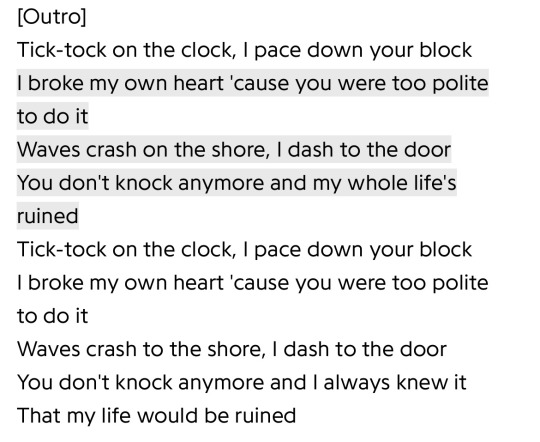

*for posterity, i included the apple music lyrics as the genius lyrics appear to be worded partially incorrectly
this is the part of the song which i just think is so beautifully done. in particular i love the “you don’t knock anymore” of it all
at first it sounds like she’s saying karlie doesn’t knock anymore because she come around anymore, or this idea of there having been a breakup or a period of not being together or something sad, which is matched by the tone of how she sings it for the first time. the waves crashing to the shore feels like a storm.
but at the end of the repetition her voice becomes more upbeat and it dawns on you, you’re like, oh wait karlie doesn’t knock anymore because she doesn’t need to knock anymore, she has a key! (“is that your key in the door?” anyone?)
and suddenly the waves meeting the shore is a pleasant image of unification and happiness. she closes with the thought “you don’t knock anymore and i always knew it” which makes it feel a bit more like mastermind’s “you knew the entire time, and now you’re mine” — always knowing they would get together, taylor always knowing karlie was the one. “and my life had been ruined” is sung in a sort of sweet resignation, one that i find throughout a lot of kaylor music, the idea that she knows its complicated but that its what she chose.
so yeah! that’s why suburban legends is a kaylor song to me 😌
225 notes
·
View notes
Text
Greek monster myths (1)
Various mini-articles loosely translated from the French « Dictionary of Feminine Myths », under the direction of Pierre Brunel. (You could also translate the title as “Dictionary of Female Myths” – the idea being all the myths centered around women)

Article 1: Gorgô
[Note: this mini-article is distinct from the mini-article about “Gorgons”]
The appearance of Gorgô, at the end of the eleventh chant of the Odyssey, is meant to cause fright – not just to Odysseus himself who is just done with invoking the dead, but also to the audience hearing this rhapsody (the Phaeacians listening to Odysseus’ tale), and to the very listener of the Homeric poem. Gorgô forms the dominant peak of this “evocation of the dead” (nekuia), she is the “chlôron déos”, the “green fear”. Odysseus’ mother, Anticleia, just disappeared back again nto the Hades – the hero wishes to summon other shades, such as those of Theseus and of his former companion Pirithous, “but before them, here is that with hellish cries the uncountable tribes of the dead gathered”. And Odysseus adds: “I felt myself becoming green with fear at the thought that, from the depths of the Hades, the noble Persephone might sent us the head of Gorgô, this terrible monster…” (633-635). It is barely an apparition, it is the possibility of an appearance, but it is enough to terrorize the living.
Jean-Pierre Vernant, in his work “La Mort dans les yeux” (Death in the eyes), establishes the link which ties together Gorgô and Medusa. Because Gorgô is more than a singular unification of the three Gorgons: she is a superlative form of Medusa, she is what happens when her petrifying gaze survives beyond death. By studying the depictions of Gorgô in ancient statues, Vernant establishes two fundamental traits: the faciality, and the monstrosity. He explains that “interferences” take place “between the human and the bestial, associated and mixed in diverse ways”. Maybe Gorgô is, as Vernant suggests, “the dark face, the sinister reverse of the Great Goddess, of which Artemis will most notably be the heir”. But Gorgô is also placed in the function of watchful guardian of the world of the dead, a world forbidden to the living. The mask of Gorgô expresses the radical alterity of Death and the dead.

Article 2: The Graeae
Daughters of Keto and Phorkys (they are thus also called “The Phorcydes”), sisters of the Gorgons, these divinities of shadows, which were born as elderly women and doomed to share one eye and one tooth for all three, appear exclusively in the tale of Perseus and Medusa.
The most ancient mention of the Graeae comes from Hesiod’s Theogony, which only counts two of them and names them Pemphredo and Enyo (Enyo was also the name of a goddess of war within Homer’s Iliad). The third of the sisters appears within a fragment of the Athenian logographer Pherecyde: Deino (“The Dreadful”), later called Persis by Hyginus (in his “Preface to fables”). Other authors, like Ovid, prefer to stick with two Graeae. Hesiod makes a quite flattering portrait of them: he makes them elegant goddesses with a “beautiful face”, even though they were “white-haired (understand “having white hair due to old age”) since birth”. And while their very name means “old women”, the Antique iconography actually follows the Hesiodic model: the depictions of the sisters as disfigured by the effects of time are quite rare… At most the artists will just put a few wrinkles. These mysterious hybrids between youth and old age, virginal seduction and sinister ugliness, finds an echo within a few lines from Aeschylus “Prometheus bound”: “Three ancient maidens, with swan bodies, that share a single eye and a single tooth, and who never receive a look from the shinng sun or the crescent of the night.” Aeschylus had an entire tragedy written about them (Phorcydes) which was unfortunately lost – but Aristotle wrote about it in his “Poetics” and implies that the play insisted on their monstrous aspect, placing them within the legendary area known as “the gorgonian fields of Kisthene”, and closely associating them with their sisters, of which they form a reversed image. Indeed, the Gorgons have a very powerful eyesight which no mortal being can face, while the Graeae have an extreme form of blindness. This trinity of women, old by nature, can also be understood as the antithesis of the three Charites, the Graces which embodied eternal youth.
The Graeae seems to have only a role within the myth of Perseus. And, outside of a few details, this legend does not change much from Pherecyde to Ovid’s Metamorphoses, passing by Lycophron, Apollodorus’ Bibliotheca, and Hyginus’ Astronomy. In all those versions the Graeae are the jealous keeper of the secret path that leads to the Gorgons, and Perseus must steal their eye in order to obtain the knowledge needed to reach Medusa. However, Pherecyde did change an element: according to him the Graeae do not protect the path leading to the Gorgons, but rather the path leading to the nymphs that hold the magical items Perseus needs to fight Medusa.
Due to their limited presence in Greek mythology, the Graeae have quite a poor cultural posterity. In the 19th century Goethe will remember them: in his “Second Faust”, Mephistopheles appears under the guise of “Phorkyas”, a monster with only one eye and one tooth. In the world of paintings, Edward Burne-Jones, who created a true “Perseus cycle”, had a strong interest for them: he worked for a very long time on a painting of the Graeae. Their face is barely visible, but the cloth that wraps itself around their body is menacing ; they are within an arid desert, under a dark sky heavy with clouds – they perform a sinister dance, in a mockery of the Graces. Perseus comes to steal their eyes, and the grey color that invades all the nuances of the picture symbolizes the unique presence of those strange crones, both disquieting and pitiable.

Article 3: Echidna
Echidna, “the viper”, is according to Hesiod the daughter of Phorkys and Keto, themselves born of Pontos, the Sea, and Gaia, the Earth. Echidna’s sisters are female monsters like her: the Graeae, and the Gorgons. Hesiod describes her as having half of the body of a “fair-cheeked nymph”, while the rest of her body is the one of an enormous, big, cruel, spotted and terrible snake which “lies within the secret depths of the divine earth”. Echidna as such belongs to this large mythological family of snake-women, of which the most famous case in France is the fairy Mélusine. But unlike Mélusine, Echidna can never leave the snake-half of her body, and thus a better French heir would be Marcel Aymé’s depiction of the vouivre with her cohort of vipers.
Theodore de Banville, when he imagines Hesiod scolding him for sanitizing Classical mythology, makes of Echidna the symbol of the archaic mythology: he tells him that he is “making a toy out of the history of the gods” by depicting Love as “a sweet child, free of carnivorous appetites, ignored by the Furies and by bloody Echidna”.
Echidna precisely appears as a being led by an amorous desire within Herodotus’ tales, that he claims to have collected among the Greeks of Pontus Euxinus: as Herakles was sleeping, Echidna steals his horses away. She only agrees to give them back if he sleeps with her. When Herakles leaves her, she tells him that she will bear three sons from their union. He advises them to only keep with her one that would be able to bend a bow just like him, and to force the others to leave. She does that, and this favorite son is supposed to be the one that created the Scythian people. This meeting between Herakles and Echidna might be derived from the famous encounters between Herakles and three of Echidna’s other children: the Nemean Lion, the Hydra of Lerna, and Cerberus.
In Aeschylus, Orestes compares his mother, Clytemnestra, to “a horrible viper”. Sophocles has Creon call Ismene, which he believes to have helped Antigone, “a viper that slid in my house against my will to drink my blood”. These examples show a link between the Ancient metaphorical speech, and the mythological allusions. Indeed, only the context can allow us to determine if these authors meant “viper” as a common name, or as a proper name: as “Viper”, “Echidna”. But it confirms the idea that, in Ancient Greece, Echidna is a monster born of an archaic fear of the women, and embodying their supposed perfidy.
#greek mythology#graeae#gorgon#gorgo#medusa#echidna#greek monsters#female monsters#ancient greek monsters#greek myths
76 notes
·
View notes
Photo

Revolts and revolutions in Italy under the Restoration
“Atlante storico”, Garzanti, 1966
by cartesdhistoire
The Congress of Vienna divided Italy into ten largely reactionary states, against which the secret society of Charbonnage, originating in the Kingdom of Naples in 1807, opposed itself. The "Carbonari," mainly from the middle classes, whose growth had been favored by French domination, claimed inspiration from the constitution of Cádiz promulgated by the Spanish parliament with Napoleon's agreement in 1812.
Revolutionary movements erupted first in Naples in the summer of 1820, followed by Palermo, which became the scene of a genuine civil war. The insurrection spread to Piedmont from March 1821; the insurgents were defeated in Novara on April 8, with Austrian assistance, leading to ruthless repression until October. Order on the peninsula was only fully restored in early 1822 by the Austrian army. Severe anti-liberal repression was felt in Modena, the Papal State, and Milan. At least 3,000 patriots went into exile between 1821 and 1823.
Echoing the Parisian revolution of 1830, which had a profound impact in Italy, an uprising erupted in early 1831 in Modena, Parma, and Bologna. On March 4, the Austrian army entered the Duchy of Modena, and on the 29th, the last remnants of the insurgent army capitulated. Fierce repression followed.
Patriots were divided into two models: revolutionary and democratic or liberal and moderate. The latter, itself subdivided into two currents, one advocating unification under the pope's auspices and the other under the leadership of the House of Savoy. The revolutionary model, predominant until 1848, found its embodiment in Giuseppe Mazzini, who envisioned a popular insurrection to overcome resistance from princes and local particularisms, leading to a republic. Mazzini's activism played a significant role in shaping the Italian people's national consciousness, but the utopian nature of the insurrectional path ultimately led to a deadlock.
70 notes
·
View notes
Text


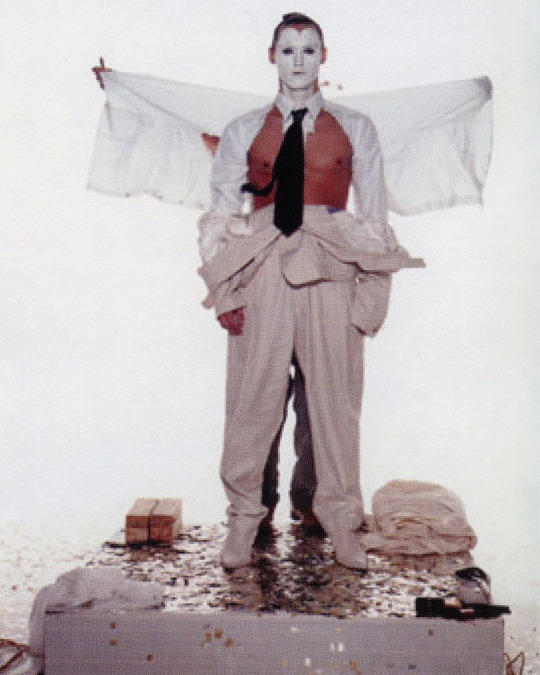

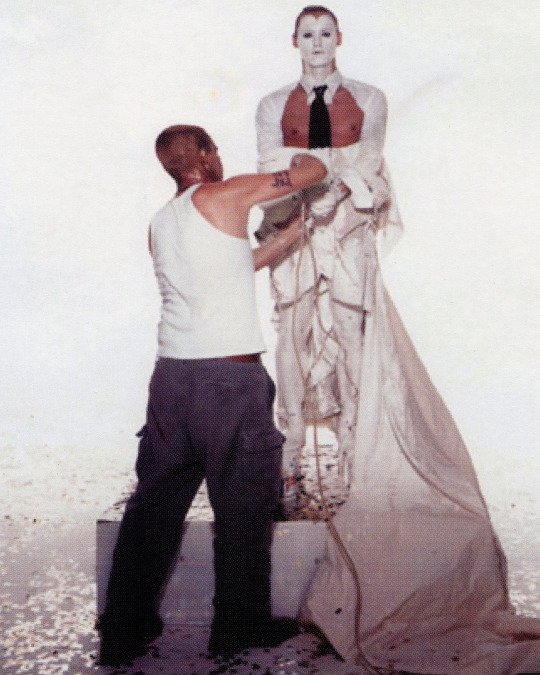

"…to wear a wedding dress means at least a kind of success. The unification and combination of men and women. That is what is called happiness…", Alexander McQueen
In 2002 Nick Knight followed a series of fashion designers, models, stylists, celebrities and performers for SHOWstudio.
The guests were followed with three viewpoints. With two films drawn from Webcam footage, watch the models arrive, the stylists work and the celebrities socialize as the sixteen fashion stories unfold. The footage was edited to show exactly what went on in front of Nick Knight's camera. The third viewpoint were the Polaroid images that showed the evolution of each evolving story.
The tradition of a couture show, is to end with a wedding dress. The final of Transformers, September 19, was the time for Alexander McQueen to do his work. He made a bride out of a groom in a gender bending fashion performance.
follow on Instagram for more
351 notes
·
View notes
Text

Happy Valentine's Day, everyone! It's time to start thinking about Marinette March. This year's calendar was once again created by the very generous and lovely @ayydrienagreste. Be sure to send him lots of love!
Just like last year, if you want to participate, be sure to tag your posts #marinettemarch2024 or @ mention this blog, and I will reblog your submissions here. Both prompt-specific and general submissions will be accepted. A few ground rules:
This is a salt free event. This includes harsh criticisms of the show, characters, ships, or fandom involved with it.
Ship content is allowed, so long as Marinette is the center of the work
NSFW is allowed, but please tag it and put it under a read more
For the purposes of this event, Shadybug/alternate Marinette is allowed (obv. seeing as it's the first prompt, but this applies to all prompts)
I'm looking forward to this year's event, and hope you all are too! Please reblog and spread the word. The prompts are listed in order under the cut.
Shadybug
Insecurities
Crafty
New school
Swimming
Girl friends
Power-ups
Overslept
Pink
Leader
Heritage
New suit
Kwami unification
Secrets
Late nights
Polka dots
Crazy schemes
Growing up
Sacrifice
Lucky charm
Heart on her sleeve
Exercise
Dear diary
Dream dress
Balcony
Tea time
Villainess
Role models
Sick day
Anxious
Memories
#miraculous ladybug#marinette dupain-cheng#ladybug#shadybug#toxinelle#marinette march#marinettemarch2024#fandom events#ml fandom events
71 notes
·
View notes
Photo

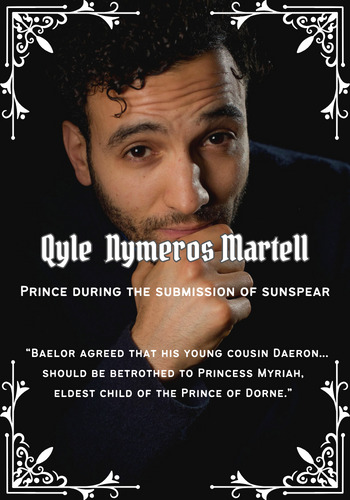




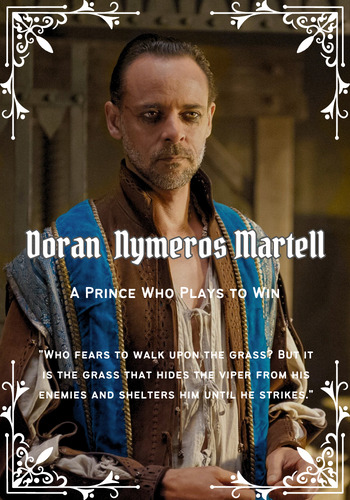

The Ruling Princes and Princesses of Dorne
Leaders During the Unification with the Iron Throne
Aliandra Nymeros Martell - Nora Attal
Qyle Nymeros Martell - Marwan Kenzari
there’s two potential candidates for who the prince of sunspear was during daeron i’s war so I included both of them because it made the number even.
Qyle, Aliandra’s younger brother, is one of those candidates, because we don’t know if Aliandra ever had children
Qyle would have been a bit older by the submission of sunspear which is why I went with Marwain Kenzari
Marence Nymeros Martell - Rayane Allali
Elio and Linda give Maron and Myriah’s father the name “Marence” in the game Blood of Dragons.
It’s only semi canonical though and it should be noted that we don’t know how he’s related to Aliandra.
More on all that in my “who the hell is maron and myriah’s father” meta.
If Marence is Aliandra (or Qyle)’s son, he likely would have been a bit young when Daeron’s war starts so I went with a younger face for him
Maron Nymeros Martell - Tahar Rahim
Maelor Nymeros Martell - Fu'ad Aït Aattou
I specifically looked for a mixed model for this one, and Fu’ad is French and Moroccan.
Now, obviously Maelor is a Valyrian name, but it’s close to a Dornish one as well - Mallor.
I thought, given how much Maron is said to love Daenerys as well as the story Doran tells of Daenerys teaching her son how to rule, that Daenerys had a heavy hand in raising him and perhaps in naming him as well, something virtually no other lady has control over in the series
Hence, Maelor - it sounds like Baelor, it’s a less common Valyrian name, but it sounds Dornish enough as well. Kind of a meeting of both cultures, just like their son would be.
Loreza Nymeros Martell - Leila Bekhti.
This meta here lays out why Loreza is likely her name but to sum up:
Oberyn is clearly trying to reunite his family through the names of his children with Ellaria. Elia, Obella for himself, Doreah for Doran, and Loreza probably for his mother.
Doran Nymeros Martell - Alexander Siddig
Can you believe they wasted the perfect casting choice on that nonsense?
Arianne Nymeros Martell - May Elghety
#valyrianscrolls#valyriansource#asoiafedit#a song of ice and fire#house martell#house nymeros martell#maron martell#doran martell#arianne martell#loreza martell#loreza nymeros martell#aliandra martell#marence martell#arianne nymeros martell#doran nymeros martell#aliandra nymeros martell#maron nymeros martell#rani graphics#i think nora and rayanne and tahar and fu'ad look fairly alike and i'm proud of myself for those#i actually also think the loreza/doran/arianne one is good too. this one was a lot easier for fancasts i think i just had a clearer idea#of what i wanted them all to look like. obviously bc these martells are pretty well fleshed out#even loreza tho she doesn't have a name.
71 notes
·
View notes
Text
Sardar Patel: Unifier of India, Visionary of Progress
Share your thoughts on Sardar Patel's legacy. What inspires you most about the Iron Man? Let's celebrate his vision together!
Beyond ironclad leader, Sardar Patel was a visionary architect of India’s unity and progress. Unravel his strategic genius, social justice champion, and enduring legacy. Dive into the story of the Iron Man who forged a nation.
[email protected] Iron Man Forged in UnityThe Unifier’s Crucible:From Barrister to Statesman:The Master Strategist:Beyond Borders, Building a NationBeyond…

View On WordPress
#biography#development#India#infrastructure#Leadership#legacy#Modern India#Nation Building#Political History#princely states#Role Models#Sardar Patel#social justice#Unification#vision
0 notes
Text
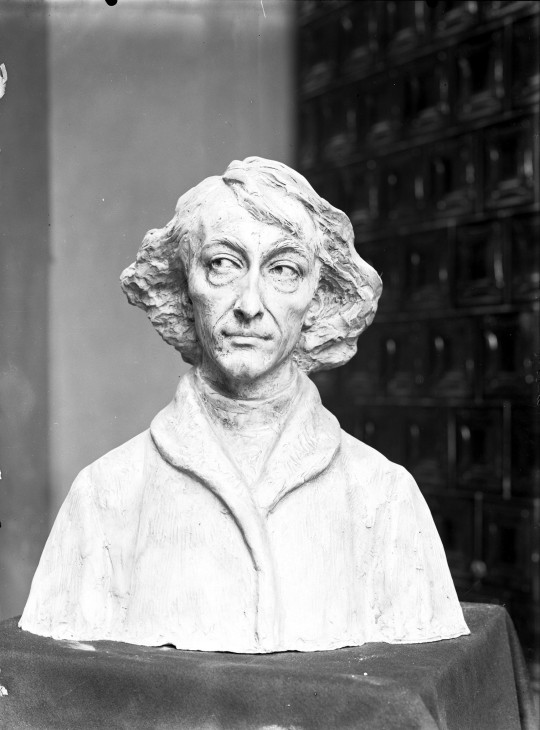
Nicolaus Copernicus (Konstanty Laszczka, Polish sculptor)
Happy birthday, Nicolaus Copernicus!
Nicolaus Copernicus (February 19, 1473 — May 24, 1543) is primarily known as an exceptional astronomer who formulated the true model of the solar system, which led to an unprecedented change in the human perception of Earth’s place in the universe. This great Pole, who is rightly included among the greatest minds of the European Renaissance, was also a clergyman, a mathematician, a physician, a lawyer and a translator. He also proved himself as an effective strategist and military commander, leading the defence of Olsztyn against the attack of the German Monastic Order of the Teutonic Knights. Later on, he exhibited great organizational skills, quickly rebuilding and relaunching the economy of the areas devastated by the invasion of the Teutonic Knights. He also served in diplomacy and participated in the works of the Polish Sejm.
Copernicus’ scientific achievements in the field of economics were equally significant, and place him among the greatest authors of the world economic thought. In 1517 Copernicus wrote a treatise on the phenomenon of bad money driving out good money. He noted that the“debasement of coin” was one of the main reasons for the collapse of states. He was therefore one of the first advocates of modern monetary policy based on the unification of the currency in circulation, constant care for its value and the prevention of inflation, which ruins the economy. In money he distinguished the ore value (valor) and the estimated value (estimatio), determined by the issuer. According to Copernicus, the ore value of a good coin should correspond to its estimated value. This was not synonymous, however, with the reduction of the coin to a piece of metal being the subject of trade in goods. The ore contained in the money was supposed to be the guarantee of its price, and the value of the legal tender was assigned to it by special symbols proving its relationship with a given country and ruler. Although such views are nothing new today, in his time they constituted a milestone in the development of economic thought.
Additionally Copernicus was not only a theorist of finance, but he was also the co-author of a successful monetary reform, later also implemented in other countries. It was Copernicus, the first of the great Polish economists, who in 1519 proposed to King Sigismund I the Old to unify the monetary system of the Polish Crown with that of its subordinate Royal Prussia.
The principles described in the treatise published in 1517 were decades later repeated by the English financier Thomas Gresham and are currently most often referred to around the world as Gresham’s law. Historical truth, however, requires us to restore the authorship of this principle to its creator, for example through the popularization of knowledge about the Copernicus-Gresham Law. (© NBP - We protect the value of money).
#nicolaus copernicus#mikołaj kopernik#sculpture#poland#science#konstanty laszczka#scienceblr#scientists#science academia#astronomy#thomas gresham#science history#renaissance#16th century#polish artist#study inspiration#solar system#planets#prussia#kingdom of poland#*
257 notes
·
View notes
Photo






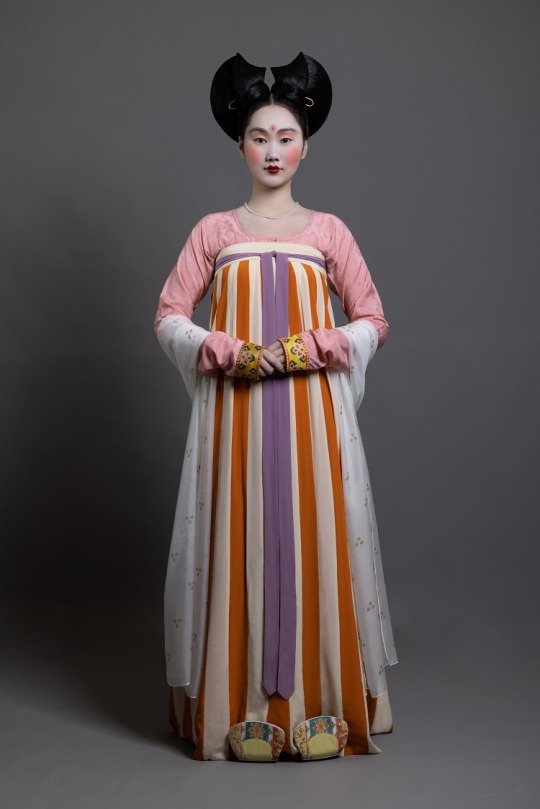


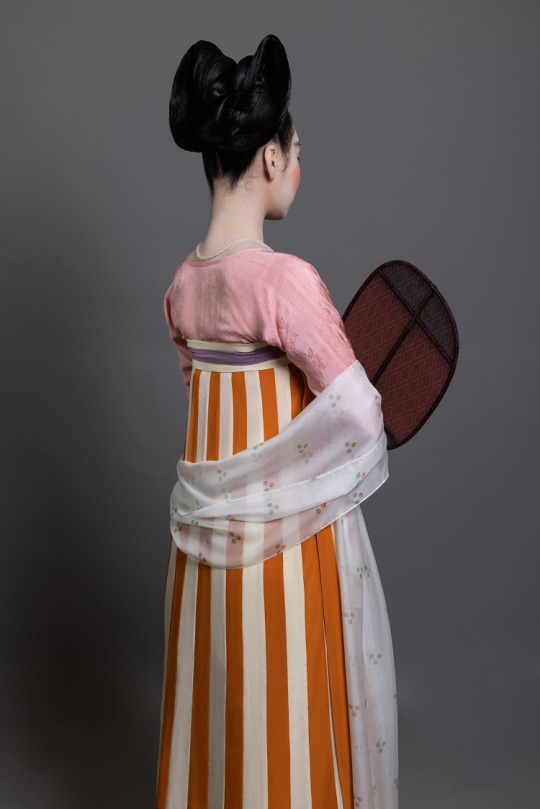
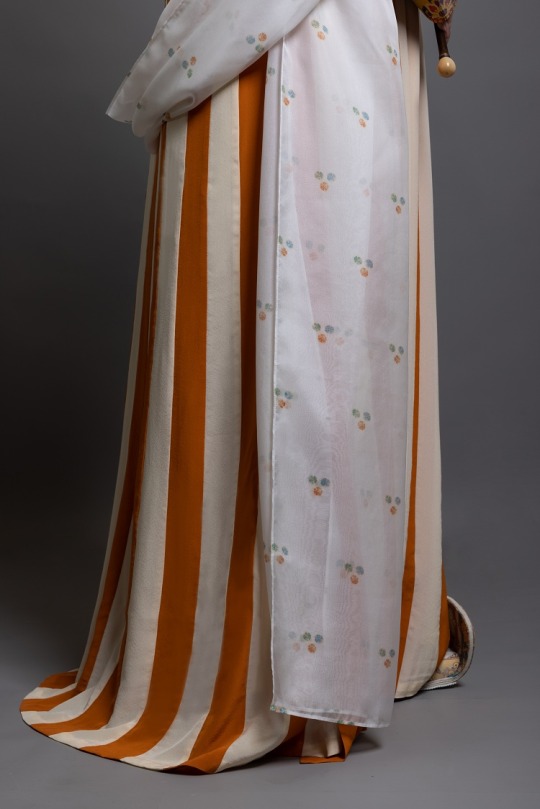
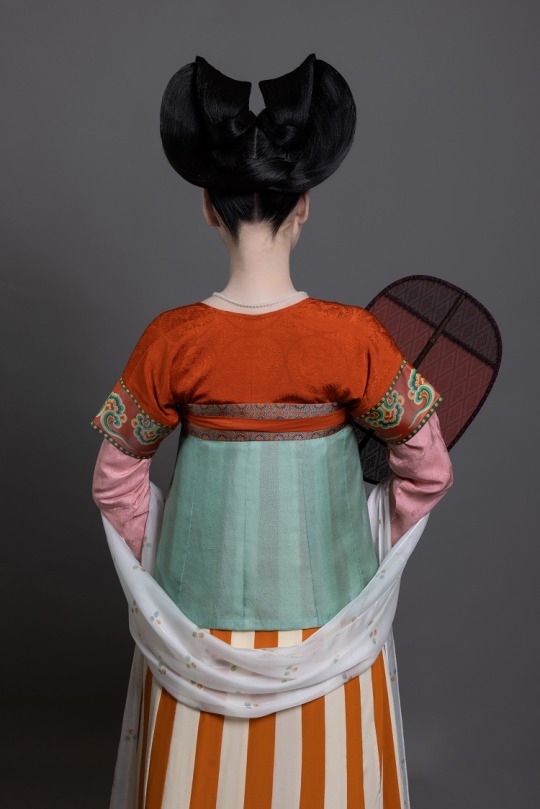
【Historical Artifacts Reference】
Murals in the Tomb of Princess Xin Chang, Liquan County, Shaanxi Province/陕西省礼泉县新城长公主墓壁画 (663 AD)
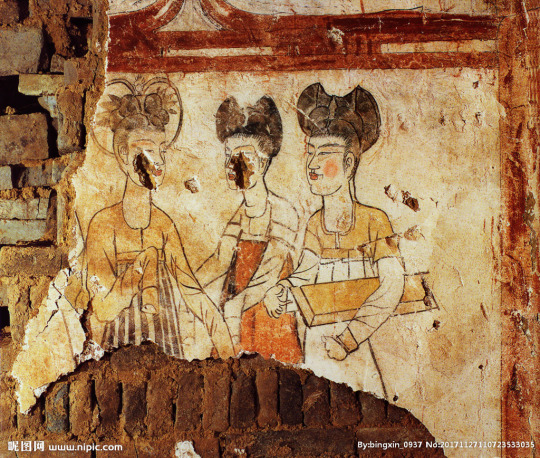


[Hanfu · 漢服]Chinese Tang Dynasty (618–907AD) Traditional Clothing Hanfu & Hairstyle Based On Relics Murals in the Tomb of Tang Princess Xin Chang
Women’s Clothing, Hairstyle in the Early Tang Dynasty Period (663 AD)
—————-
【History Note】
After the establishment of the Tang Dynasty, with the completion of the great unification and the recovery of the social economy, the stable status of a big country brought a confident and enlightened cultural atmosphere, which was fully reflected in clothing and social customs.
At that time, all the noble ladies in the palace liked towering hairstyles, and advocating slender clothing was the fashion, showing a tall and elegant temperament as a whole. In such popular aesthetics, the combination of high buns and inter-color skirt became all the rage and became a representative attire in the early Tang Dynasty.
In addition, the makeup gradually deviates from the relatively plain style in the past, and develops into more gorgeousness. The red makeup that put on the cheeks becomes thicker and the range gradually expands. The shape of eyebrows has changed from slender eyebrows to bold thick eyebrows, and face decorations such as Huadian(花钿) and XieHong斜红() are also more prominent.
※ Huadian(花钿) :traditional Chinese ornamental forehead makeup
※ XieHong (斜红) : a special kind of face decoration in ancient times. When dressing up, a red crescent is drawn on both sides of a woman’s eyes.
In this set of attire, the model hair in a double bun, wears a narrow-sleeved blouse with brocade margins on the inside, half-sleeves with brocade margins on the outside, and a inter-color skirt,a light gauze wrap around her body. It was a popular dress in the Tang Palace during this period.
On the occasion of the Spring Festival, 裝束复原 Team wishes more people get to know about the traditional Chinese costume culture. At the same time, wish every friends around the world have a happy New Year!
————————
Recreation Work: @裝束复原 & @桑纈
🔗Weibo:https://weibo.com/1656910125/Mpl9wlxE5
————————
#Chinese Hanfu#Tang Dynasty (618–907AD)#Hanfu#Early Tang Dynasty Period (663 AD)#Tomb of Tang Princess Xin Chang#hanfu history#chinese history#china history#Chinese historical fashion#historical makeup#historical fashion#chinese traditional clothing#chinese#chinese new year#spring festival#Chinese Culture#recreation#chinese art#Chinese Aesthetics#chinese fashion history#裝束复原#桑纈#Huadian(花钿)#XieHong (斜红)#shanqun#pibo#间色裙 (inter-color skirts)#漢服#汉服
290 notes
·
View notes
Text
My first 3d model, and it’s the Jade Dragon statue from Unification Temple!
youtube




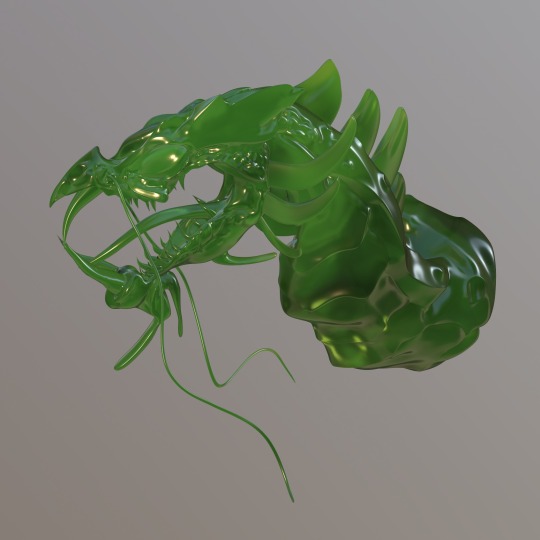
#ninjago#ninjagood4#ninjago oc#My oc#ninjago dragon#dragon#my novel#ninjago jade#3d model#first#Youtube
34 notes
·
View notes
Photo


ATTENTION TO ANY LISTENING DRACS, SCARECROWS, EXTERMINATORS, PIGS, AND ANY OTHER FUCKIN’ LOSERS ON THEIR CITY DIALS – SHOW PONY HERE: YOU FUCKIN’ SUCK! KISS MY METAL!
if you were around on my main blog for my danger days/killjoy days, you know i was a huge show pony fan. and now i have way too much cc downloaded so what the fuck, here’s my show pony. they fucking rule.
(click images for higher quality! cc list and creator tags under the cut)
see my resources page!
anything not listed is from either base game, get famous, discover university, cottage living, or paranormal.
all: mosaica’s tequila sunrise cas lighting / catsblob’s unif model poses / catsblob’s simple model poses v.4 / lou-from-moonwood’s cool enough poses / breezygardensofficial’s aleksander hair / saruin’s andro masc presets / katpurpura’s apocalyptic burns (tsr download) / objuct’s robot dermals v.2 / bedisfull’s we are young rollerskates
look one: zombietrait’s destroya blush / cloudcat’s no halo mesh top / candysims4′s jonathan tank top / ridgeport’s mynx tights / nemesym’s kneepads
look two: cerberus-sims’ respirator / nemesym’s kneepads
look three: mechtasims’ heart headset / wistfulcastle’s night city gloves
look four: deathpoke1qa’s band tease (i just think im soooo funny using the danger days swatch huh) / joliebean’s nutcracker shorts / nemesym’s kneepads / trillyke’s body rhythm tights
thank you to @mosaica @catsblob @lou-from-moonwood @breezygardensofficial @saruin @katpurpura @objuct @bedisfull @tricoufamily @cloudcat @candysims4 @ridgeport @occult-cc-finds @mechtasims @wistfulpoltergeist @deathpoke1qa @the-crypt-o-club @joliebean @trillyke !!!!!
#my sims#sims 4 lookbook#the sims 4 lookbook#ts4lookbook#ts4 lookbook#danger days#killjoyverse#show pony
74 notes
·
View notes
Text
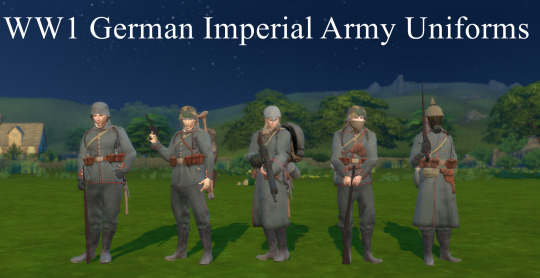
Hi Guys!! :D Long Time no see! I hope things are going well for everyone , Sorry for long ass Hiatus I had for all these times, I Got very Busy on Real Life stuff and Shits and I Even Barely Remember to continuing My Works here.. But Anyways show must go on. Thank you to @chere-indolante For Inspiration. Let's Just say it was Upgrade to Her Work With More Detailed Gear and More Variety of Helmet LOL.
DOWNLOAD
The Imperial German Army or Deutsches Heer was the name given to the combined land and air forces (excluding the Marine-Fliegerabteilung maritime aviation formations of the Navy) of the German Empire. It was formed after the unification of Germany under Prussian leadership in 1871 and dissolved in 1919, after the defeat of the German Empire in World War I.
Tech Specs
Coverted From "Battlefield 1" Game, Credits belongs to Electronic Arms
This Particular Uniform Belongs to German Imperial During Early Stages of war (1914-1916) since Later Uniform is more simplified.
1 Color Swatch fot all Uniform
HQ Compactible.
Male Only
UNIFORMS


Assault - Wearing tunics, scarfs and Stalhelms (the front of the helmet camouflaged by a brow plate). With smaller details such as leather pistol holster on his chest and ammo pouches around their stomach. As with all classes, one can identify which gun a certain class is using, with players holding SMGs having their weapons at their shoulders while shotguns are held at their waist.
Rifleman - Light Version of "Assault" Team, Wearing Exact configuration of said team. but only wearing A Rifle pouch. Most common sight in WWI German Front
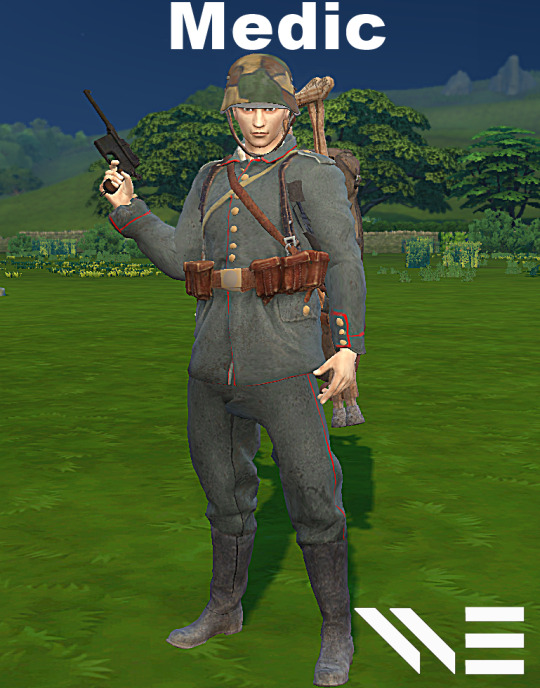
Medic - Wearing tunics, with crutches and backpacks on the back and grey Stalhelms. With smaller details being ammo pouches around their stomach and water canteen on the right side. Medics hold their rifles generally at their shoulders, while running they point them downwards.

Support - Wearing trench coats, with heavy backpacks on their back and the Gaede Helmet. With smaller details being ammo pouches around their stomach with additional pouches underneath them, water canteen on their right side. Supports hold their Machine guns around their waist.

Scout - Wearing a trench coat and a Stalhelm. With smaller details being ammo pouches around their stomach with additional pouches underneath their right side and a sidearm holster on their left side. Snipers hold their rifles at the shoulder when walking and point them downward while running, similar to the Medic.
HELMET

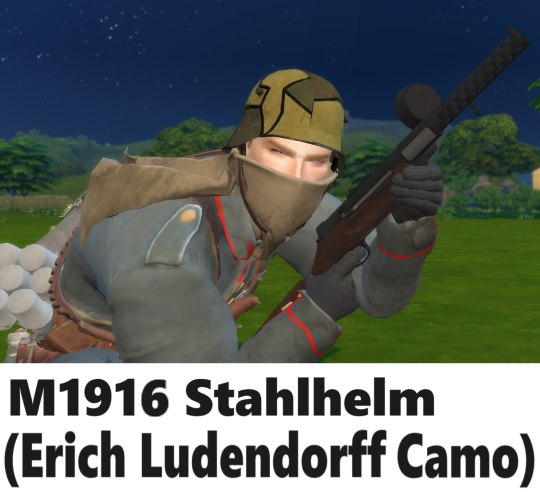
Stahlhelm M1916 - The Stahlhelm M1916 is an improved version of the German steel helmet introduced during World War I. Similar to the M1915, it features a distinctive design characterized by a rounded shape, a flared skirt, and a protruding visor. The M1916 model included enhancements to address issues with the earlier version, providing better protection to the wearer. It became a standard-issue helmet for German forces during World War I and continued to see use in various forms during subsequent conflicts. this is the Earliest version of Infamous German Stahlhelm that first fielded inside Imperial German Army. So don't Expect Better Protection like The Later model or WW2 Models. this also Include A German Tricolor Camouflage Designed by General Erich Ludendorff that Eventually Fielded in 1918.
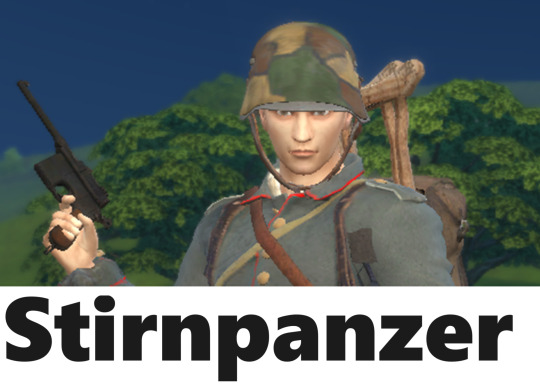
Stahlhelm Stirnpanzer - Due low Durability and Protection of M1916 Stahlhelm, German Ministry of War Issued Minor Upgrade. a The brow plate (Stirnpanzer), which was fitted to the front of the helmet to provide additional protection to the wearer. However, it's weight (2 kg) meant that it could only be worn for short periods. Approximately 50,000 brow plates were manufactured.
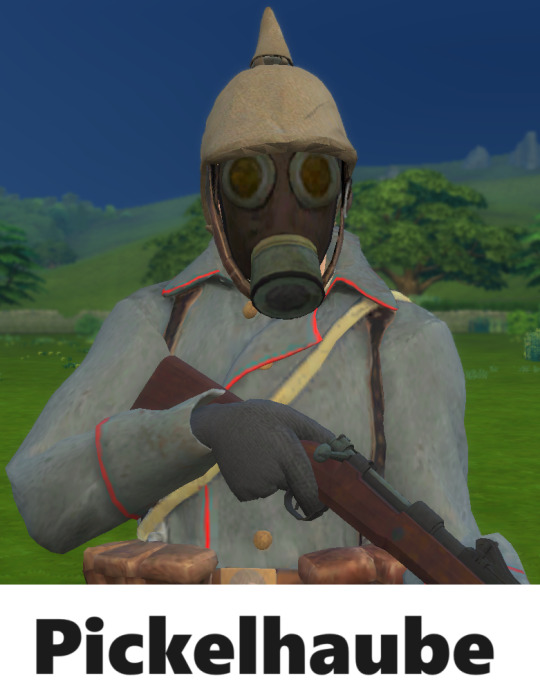
The Pickelhaube - The Iconic Helm From Prussian Era now Brought back to WWI Fronts. ickelhelm, is a spiked leather or metal helmet that was worn in the 19th and 20th centuries by Prussian and German soldiers of all ranks, firefighters and police. Although it is typically associated with the Prussian Army, which adopted it in 1842–43, the helmet was widely imitated by other armies during that period. It is still worn today as part of ceremonial wear in the militaries of certain countries, such as Sweden, Chile, and Colombia. This Particular Model is cloth helmet cover (Überzug) and For Cavalary use.
Gas Mask

During World War I, Chemical warfare was a significant and notorious aspect of World War I, and Germany played a key role in its early development. The Germans were the first to use chemical weapons on a large scale, introducing chlorine gas at the Second Battle of Ypres in 1915. This marked a disturbing escalation in warfare, as chemical agents were employed to harm and incapacitate enemy soldiers.
The use of chemical weapons by both sides, including mustard gas and phosgene, led to devastating consequences, causing widespread injuries and fatalities. The introduction of gas masks became essential for soldiers to protect themselves from these toxic substances. Despite the horrific nature of chemical warfare, it did not significantly alter the course of the conflict, and international agreements such as the Geneva Protocol of 1925 later sought to ban the use of chemical and biological weapons in warfare.
Gummimaske 1915 - The Gummimaske 1915, also known as the GM 15, was a German gas mask used during World War I. It featured a rubber face mask with glass eyepieces and a filter canister containing layers of absorbent materials to protect against chemical warfare agents. The design aimed to provide effective protection for soldiers against the poisonous gases used on the battlefield during the war. The Gummimaske 1915 was an essential piece of equipment for troops exposed to the threat of gas attacks during this period.
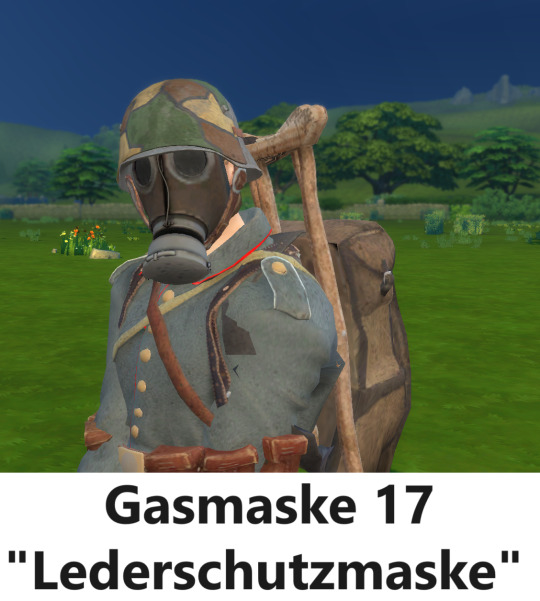
GM-17 Ledershutzmaske was introduced in 1917 to combat chemical weapons used by both sides in the First World War. It replaced the GM15 mask. It was another iteration of the German gas mask used during World War I. Similar to its predecessor, the GM 15, it featured a rubber face mask with glass eyepieces and a filter canister. The design aimed to provide reliable protection against chemical warfare agents that were employed during the war. The GM 17 continued the improvements made in gas mask technology, enhancing the comfort and effectiveness of the mask for soldiers on the battlefield. Like other gas masks of the time, it played a crucial role in safeguarding soldiers against the threats posed by poisonous gases during World War I.
#the sims 4#the sims#the sims 4 custom content#ts4#ts4 cc#ts4military#the sims 4 military#the sim#the sims 4 cc#ts4cc#ww1 germany#ww1#ww1 history#world war 1#world war one#first world war#ts4 wwi#WW1 Uniform#tw war#timeless#ts4 military
32 notes
·
View notes